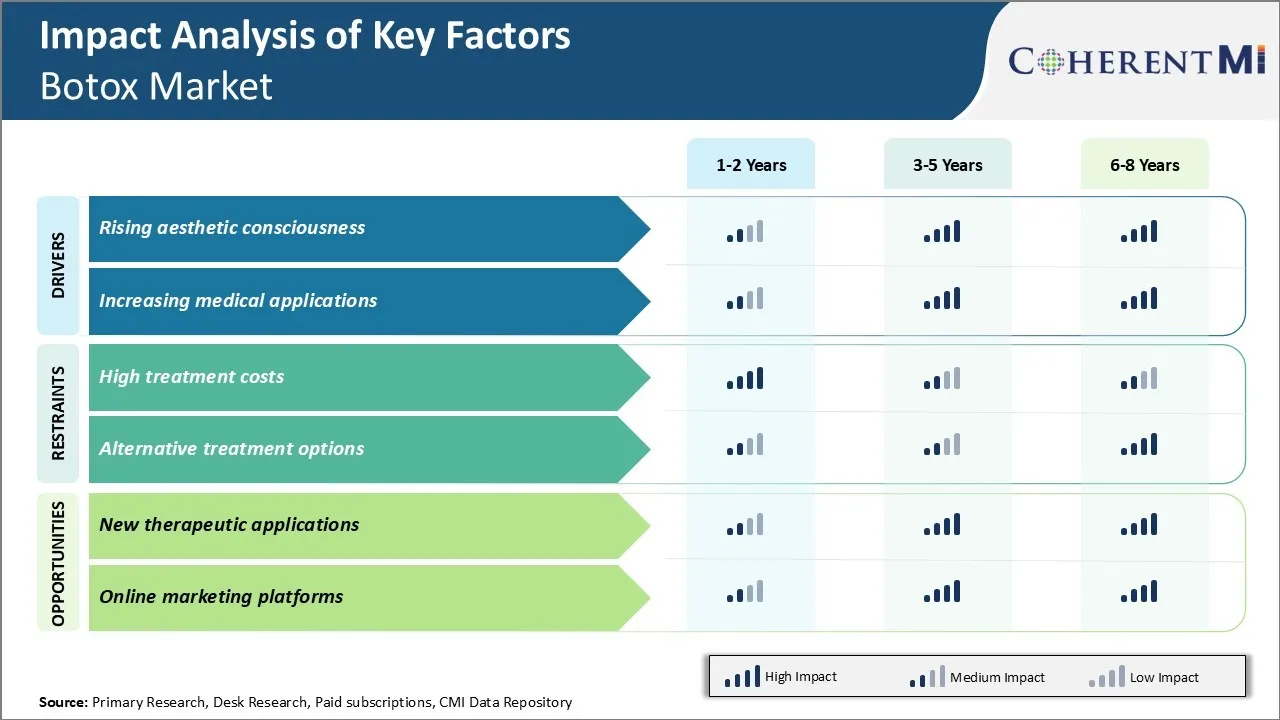Botox Market Trends
Market Driver - Rising aesthetic consciousness
As people get more conscious about their looks and appearance, they are constantly looking for ways to reduce signs of aging and retain youthful appearance. With growing focus on looks and beauty, more individuals are opting for aesthetic procedures such as Botox treatments. In today's world where physical appearance matters a lot, people want to remove fine lines, wrinkles and other signs of aging as early as possible.
Social media and popularity of selfies has also contributed towards rising aesthetic consciousness. People are highly influenced by images of celebrities and influencers who flaunt their flawless skin. There is pressure to look good in profiles and pictures posted online. Any sign of aging or imperfections tend to stand out. This drives many to undergo cosmetic enhancements. Rising disposable incomes also allow people to spend more on personal care and looking good. They consider such treatments as investments towards their appearance. A Botox session may seem expensive but its effects help retain a youthful look for many months. This lower cost per change is attracting more clients. Easy availability of financing options further makes these procedures an achievable option.
Stigma around aesthetic procedures is also fading as more discuss their experiences openly. It has become a normal thing among urban population to enhance certain features. Botox which primarily removes wrinkles from forehead, eyebrows and around eyes, is one of the most common and mainstream cosmetic treatments available. With rising consciousness, demand and acceptability, the Botox market continues to grow significantly.
Increasing Medical Applications
Initially used only for cosmetic purposes, Botox is increasingly finding greater medical uses. It has proven effective for treating many medical conditions related to muscle overactivity or misplacement. Botox injections help reduce symptoms in conditions like chronic migraines, excessive underarm sweating, bladder issues and more.
As more clinical research establishes its efficacy, doctors are using it routinely for severe forms of headache disorders, nerve pain and muscle spasticity post injuries or stroke. It provides relief where other treatment options did not work or had many side effects. Growing acceptability of cosmetic use is also limiting the stigma around medical application of Botox.
Ageing population globally has resulted in rising incidences of muscle spasticity, post-surgery pain and chronic disease aggravating factors like migraines. With limited side effects, Botox is becoming the go-to treatment preferred by both patients and doctors in many cases. Early intervention can prevent worsening of conditions and improve quality of life significantly.
Government policies in various countries are also supporting research and usage of Botox for approved medical treatments. Insurance and public healthcare coverage for such indications is expanding the reach. Hospitals and clinics are increasing training and infrastructure for administering Botox injections. Growing body of evidence to support cost-effectiveness of Botox versus alternative treatment options further encourages its usage. All these factors are expected to vastly increase usage of Botox in years to come, especially for medical conditions.

Market Challenge - High treatment costs
One of the major challenges faced by the Botox market is the high treatment costs associated with it. Botox treatment has always been considered as a cosmetic procedure falling under the category of non-medical aesthetic treatments. However, the development costs incurred by pharmaceutical companies to conduct extensive research and get regulatory approvals for new treatments and applications is quite high. This is reflected in the pricing of the final Botox products. A single Botox treatment session costs anywhere between US$300 to US$1000 depending on the area of treatment and units required. This puts the treatment out of reach for many potential customers and limits the addressable market size. Additionally, continuous efforts are required for research and development of new therapeutic areas which increases operational costs for companies. High manufacturing and distribution costs are also passed on to the final customers. With increasing competition in the medical aesthetics industry, maintaining high prices can impact the attractiveness of Botox against other cheaper alternative treatment options. Price sensitivity is particularly high in developing markets which are untapped for full potential. Overall, the industry needs to focus on reducing treatment costs through innovations to effectively penetrate new geographical regions and therapeutic segments.
Market Opportunities: New therapeutic applications
One of the major opportunities for the Botox market lies in expanding into new therapeutic application areas beyond just its usage for cosmetic purposes. Since its approval for therapeutic indications, Botox research has focused on exploring new treatment areas where it can provide relief from medical conditions. Some potential therapeutic areas that are being researched currently include chronic migraines, excessive sweating, urinary incontinence and muscle spasticity among others. Success in any of these new applications can help drive significant future revenues for companies as they target larger patient pools suffering from medical issues instead of just focusing on aesthetic treatments. Additional approvals will help strengthen the clinical profile of Botox and also reduce its dependence on cosmetic procedures alone. This can assist in removing the current perception of it being just for vanity. Various ongoing clinical trials reflect the efforts made by industry players to introduce Botox into new medical domains. Expanding the approved therapeutic footprint will be a key driver of sustainable long term growth for the overall Botox market.